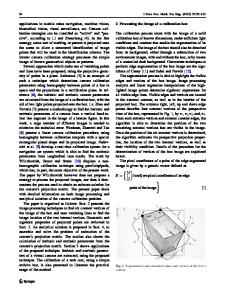Fast automatic camera network calibration through human mesh recovery
- PDF / 2,144,716 Bytes
- 12 Pages / 595.276 x 790.866 pts Page_size
- 78 Downloads / 340 Views
SPECIAL ISSUE PAPER
Fast automatic camera network calibration through human mesh recovery Nicola Garau1 · Francesco G. B. De Natale1 · Nicola Conci1 Received: 2 December 2019 / Accepted: 11 July 2020 © The Author(s) 2020
Abstract Camera calibration is a necessary preliminary step in computer vision for the estimation of the position of objects in the 3D world. Despite the intrinsic camera parameters can be easily computed offline, extrinsic parameters need to be computed each time a camera changes its position, thus not allowing for fast and dynamic network re-configuration. In this paper we present an unsupervised and automatic framework for the estimation of the extrinsic parameters of a camera network, which leverages on optimised 3D human mesh recovery from a single image, and which does not require the use of additional markers. We show how it is possible to retrieve the real-world position of the cameras in the network together with the floor plane, exploiting regular RGB images and with a weak prior knowledge of the internal parameters. Our framework can also work with a single camera and in real-time, allowing the user to add, re-position, or remove cameras from the network in a dynamic fashion. Keywords Camera calibration · Pose estimation · Human mesh recovery · 3D matching
1 Introduction In computer vision and 3D reconstruction, many works over the years have tried to automate the process of camera resectioning and calibration. Having the possibility to minimise the manual intervention within the calibration pipeline could simplify its deployment in many contexts and in a significant way. However, there is still a lack for fully unsupervised and markerless approaches for camera calibration in literature. The manifoldness of camera sensors and lenses present in the market hinders any generalization attempt. Another aspect that plays an important role in increasing the difficulty of automatic calibration is the dynamic nature of the environments, in which camera networks are generally being installed. For example, in many scenarios, including video surveillance, Ambient Assisted Living (AAL) and * Nicola Garau [email protected] Francesco G. B. De Natale [email protected] Nicola Conci [email protected] 1
University of Trento, Via Sommarive, 9, Povo, 38123 Trento, TN, Italy
environmental monitoring, the reconfiguration and consequent re-calibration of the camera network is a common process, often due to the re-positioning or addition of pieces of furniture, or, more in general, the presence of obstacles that can partially or fully limit the visibility of the observed environment. In addition, cameras with pan-tilt-zoom (PTZ) capabilities are often used. A big issue linked to the usage of PTZ cameras is that they are capable of changing their internal configuration, making it necessary to re-calibrate the whole network whenever these changes occur. In addition, wind or other weather conditions may also further complicate the scenario, introducing noise, and making it difficult to ac
Data Loading...











